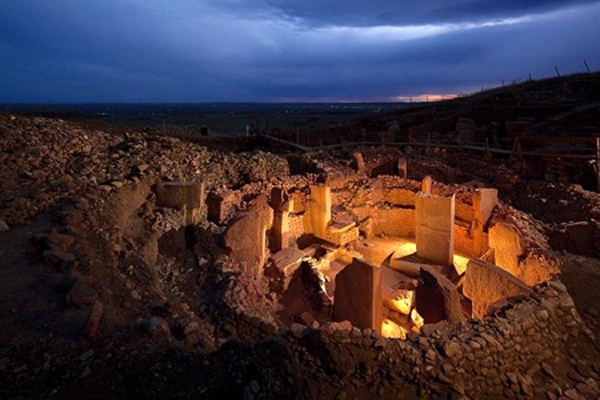


'Stone circles were homes for Man, not temples of the gods'

Extract taken from the article by Alexander Christie-Miller, The Times, October 19 2011 12:01AM
Image: Vincent J Musi, NGS
A series of mysterious stone circles said to be the world's first temple may have housed not gods but men, according to a Canadian scientist. Göbekli Tepe, a complex of huge, elaborately carved stones built 11,000 years ago on a hilltop in southern Turkey, is ranked by many as the most extraordinary archaeological discovery of the past half-century.
Predating Stonehenge by 6,500 years, the cluster of huge T-shaped monoliths bearing stylised images of people and animals were erected before humans mastered metalworking, pottery or writing and have long been recognised as the earliest example of complex religious worship.
However, in a paper published this month in Current Anthropology, Ted Banning, a professor at the University of Toronto, claims that the stone circles could have been the homes of the world's first settled people. 'If my hypothesis is correct, no one in their wildest dreams would have thought we would find houses like that in such an early period,' he told The Times.
When excavation began in 1994 the site astounded archaeologists, pre-dating by millennia other man-made structures of similar scale and complexity. Until now, they claimed that it was devoid of permanent habitation and had been a place of religious pilgrimage for Neolithic hunter-gatherers.
Professor Banning points to the discovery of vast quantities of stone-tool debris, charcoal and animal bones to suggest that the site was settled: 'It's one of the world's biggest garbage dumps. Food remains, tool fragments, charcoal; it's difficult to see where they came from unless there were people living there.'
He said the 'temple' hypothesis assumed that the builders of Göbekli Tepe drew distinctions between the everyday and the sacred, something that developed only later. The monoliths may have acted as pillars for roofed houses, and stone sickles found on the site suggest inhabitants were experimenting with agriculture. 'I'm uncomfortable with the automatic conclusion whenever we come across a building that is large and impressive that it has to be a temple,' he said.
However, Klaus Schmidt, the German archaeologist who first realised the significance of Göbekli Tepe and has led the excavation there since, dismissed Professor Banning's theory. 'I don't agree with his ideas; however, I welcome any competing explanations,' he said, declining to give more specific criticism until he has responded through an academic journal.
To view the full article click here
by Bradshaw Foundation
Tuesday 26 November 2024
by Bradshaw Foundation
Monday 27 November 2023
by Bradshaw Foundation
Friday 07 October 2022
by Bradshaw Foundation
Friday 05 November 2021
by Bradshaw Foundation
Tuesday 03 August 2021
by Bradshaw Foundation
Thursday 05 November 2020
by Bradshaw Foundation
Thursday 08 October 2020
by Bradshaw Foundation
Monday 22 June 2020
by Bradshaw Foundation
Monday 27 April 2020
by Bradshaw Foundation
Wednesday 22 January 2020
by Bradshaw Foundation
Tuesday 16 July 2019
by Bradshaw Foundation
Thursday 20 June 2019
by Bradshaw Foundation
Wednesday 08 May 2019
by Bradshaw Foundation
Tuesday 12 February 2019
by Bradshaw Foundation
Thursday 06 September 2018
by Bradshaw Foundation
Wednesday 06 June 2018
by Bradshaw Foundation
Tuesday 26 November 2024
by Bradshaw Foundation
Monday 27 November 2023
by Bradshaw Foundation
Friday 07 October 2022
by Bradshaw Foundation
Friday 05 November 2021
by Bradshaw Foundation
Tuesday 03 August 2021
by Bradshaw Foundation
Thursday 05 November 2020
by Bradshaw Foundation
Thursday 08 October 2020
by Bradshaw Foundation
Monday 22 June 2020
by Bradshaw Foundation
Monday 27 April 2020
by Bradshaw Foundation
Wednesday 22 January 2020
by Bradshaw Foundation
Tuesday 16 July 2019
by Bradshaw Foundation
Thursday 20 June 2019
by Bradshaw Foundation
Wednesday 08 May 2019
by Bradshaw Foundation
Tuesday 12 February 2019
by Bradshaw Foundation
Thursday 06 September 2018
by Bradshaw Foundation
Wednesday 06 June 2018
Friend of the Foundation











